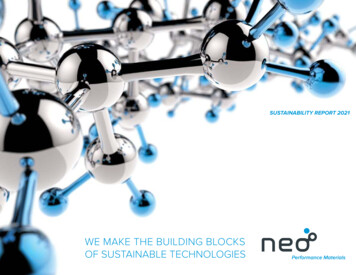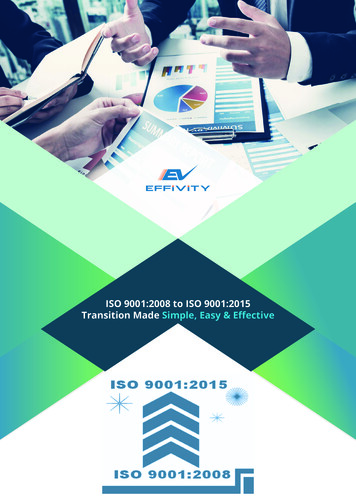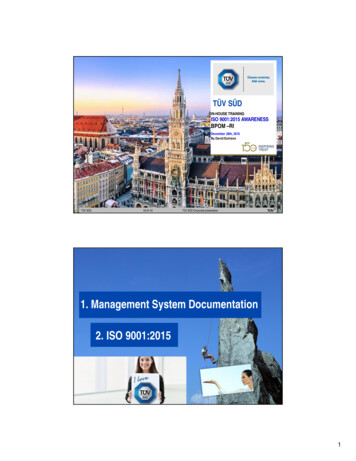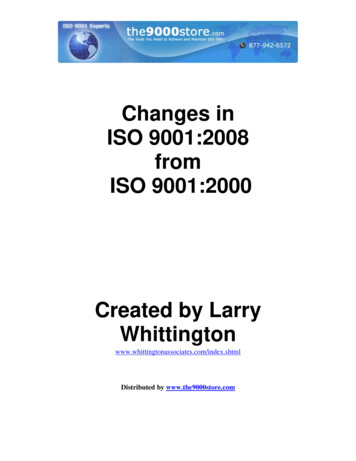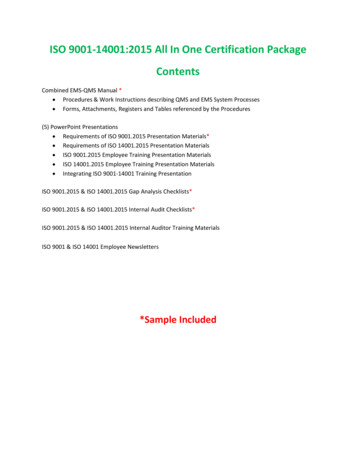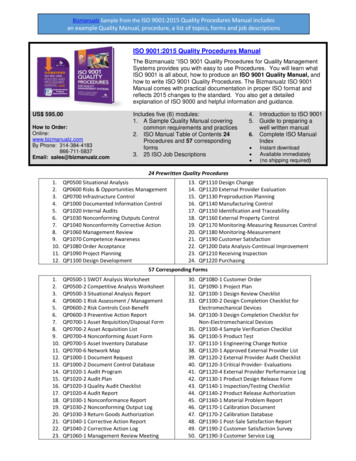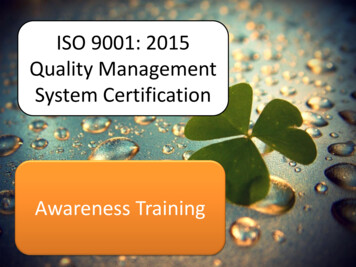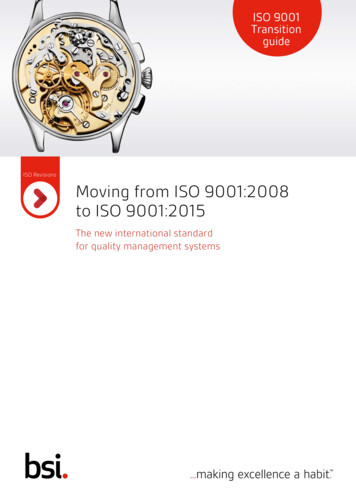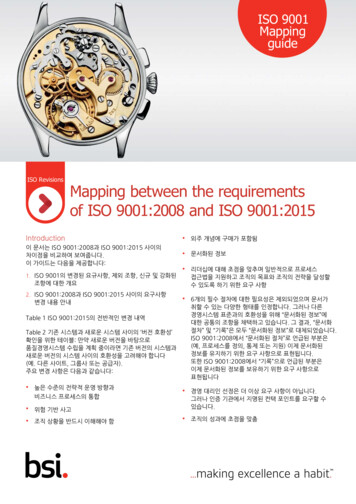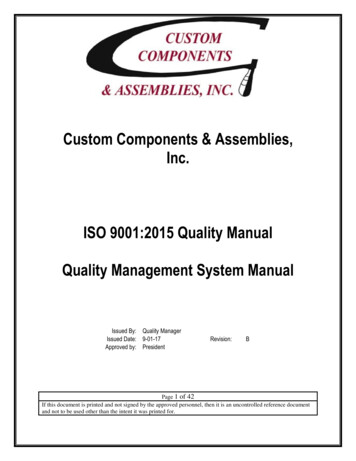
Transcription
Custom Components & Assemblies,Inc.ISO 9001:2015 Quality ManualQuality Management System ManualIssued By: Quality ManagerIssued Date: 9-01-17Approved by: PresidentRevision:BPage 1 of 42If this document is printed and not signed by the approved personnel, then it is an uncontrolled reference documentand not to be used other than the intent it was printed for.
Quality System ManualQMS1Issued by: Quality ManagerRevision Date: 9-01-17Revision: BApprovalThe signatures below certify that this management system manual has been reviewed and accepted.Demonstrates that the signatories are aware of all the requirements contained herein and are committed toensuring their provisions.DescriptionPrepared ByReviewed ByNameCory NorrisGreg ToellnerSignatureVÉÜç aÉÜÜ áZÜxz gÉxÄÄÇxÜApproved ByMark Cruze tÜ VÜâéxPositionQuality 9-01-179-01-17Amendment RecordThis quality manual is reviewed to ensure its continuing relevance to the systems and process that itdescribes. A record of contextual additions or omission is given below:Page No.ALL PAGESReasonRevised to the ISO9001:2015 StandardRevisionBDate09-01-17Company Proprietary InformationThe Electronic Version of this document is the latest revision. It is the responsibility of the individual to ensure thatany paper material is the current revision. The printed version of this manual is uncontrolled except when providedwith a reference in the field below:Document Reference: QMS1Uncontrolled Copy0Revision: BControlled Copy1Page 2 of 42If this document is printed and not signed by the approved personnel, then it is an uncontrolled reference documentand not to be used other than the intent it was printed for.
Quality System ManualQMS1Issued by: Quality ManagerTable of Contents1.2.3.4.5.6.7.8.Revision Date: 9-01-17Revision: BPageScope . .05-7References . . 7Definitions . 7-11About Our Organization .11-134.1 Organizational Context .11-134.2 Relevant Interested Parties . .13-144.3 Quality Management System .144.4 Quality Management System & Its Processes 14-16Leadership & Governance . .16-185.1 Leadership and commitment .16-175.1.1 General . 16-175.1.2 Customer Focus .17-185.2 Quality Policy 185.2.1 Establishing the Quality Policy 185.2.2 Communicating the Quality Policy . . . . .185.2.3 Quality Policy Statement . 18-195.3 Roles, Responsibilities and Authorities .195.4 Communication .20-225.4.1 Internal Communication .20-215.4.2 External Communication .21-22Management System Planning .22-246.1 Addressing Risks & Opportunities 22-246.2 Quality Objectives .22-236.3 Planning For Change .23-24Support .24-277.1 Resources .257.1.1 General 257.1.2 People .257.1.3 Infrastructure . 267.1.4 Operational Environment . .277.1.5 Organizational Know . 27Product & Service Development .288.1 Operational Planning & Control 28-308.2 Customer Requirement 28-308.2.1 Customer Communication .28-298.2.2 Determining Requirements .298.2.3 Review Of Requirements .298.2.4 Changes in Requirements .308.3 Design & Development .N/A8.4 Control Of Suppliers & External Process .30-318.4.1 General .30-318.4.2 Purchasing Controls .308.4.3 Purchasing Information 30-318.5 Production & Service Provisions .31-33Page 3 of 42If this document is printed and not signed by the approved personnel, then it is an uncontrolled reference documentand not to be used other than the intent it was printed for.
Quality System ManualQMS1Issued by: Quality ManagerRevision Date: 9-01-17Revision: B8.5.1 Control of Production & Service Provision .31-328.5.2 Identification & Traceability .328.5.3 3rd Party Property .32-338.5.4 Preservation .338.5.5 Post-Delivery Activities .338.5.6 Control of Changes . .338.6 Release of Products & Services 33-348.7 Control of Non-Conforming Outputs .349. Performance Evaluation .35-369.1 Monitoring, Measurement, Analysis & Evaluation .359.1.1 General .359.1.2 Customer Satisfaction 359.1.3 Analysis and Evaluation .35-369.2 Internal Audits .369.3 Management Review .37-389.3.1 General .379.3.2 Inputs .379.3.3 Outputs .37-3810. Improvement 38-3910.1 General 3810.2 Non-Conformity & Corrective Action .38-3910.3 Improvement .39Appendices .40-41A.1 Sequence & Interaction of Processes 40A.2 Organization Chart .41Page 4 of 42If this document is printed and not signed by the approved personnel, then it is an uncontrolled reference documentand not to be used other than the intent it was printed for.
Quality System ManualQMS1Issued by: Quality ManagerRevision Date: 9-01-17Revision: B1. Scope1.1 Introduction1.1.1It is our policy at Custom Components & Assemblies, Inc. hereinafter called CCA, to procure,manufacture and service our customer’s products that comply with contractual and regulatoryrequirements in a controlled, safe and environmentally conscious manner while constantly aimingto increase efficiency by continuously improving methods and processes.1.1.2CCA has developed and implemented a quality management system to demonstrate its ability toconsistently provide product that meets customer requirements, and to address customersatisfaction through the effective application of the system including continual improvement andprevention of nonconformities.1.1.3The quality system complies with the International Standard ISO 9001:2015.1.1.4This manual is divided into sections modeled on the sectional organization of the ISO 9001:2015standard. Sections are further divided into several subsections representing main quality systemprocesses. Each subsection defines general policies and basic principles for the pertinent qualitysystem process; summarized responsibilities and methods; and references relevant operationalprocedures and other documents.1.1.5The purpose of this manual is to define and describe the quality system, to define authorities andresponsibilities of the management personnel involved in the operation of the system, and toprovide a general description of all processes comprising the quality system.1.1.6Another purpose of this manual is to present the quality system to customers, suppliers, regulatorsand interested parties, and to inform them to what specific controls are implemented at CCA toensure a high level of quality performance.1.1.7The figure below illustrates our methodology for the development of our QMS, Using the plan, do,check and act process approach, to implement and deliver management system objectives,stakeholder requirements and environmental compliance.Page 5 of 42If this document is printed and not signed by the approved personnel, then it is an uncontrolled reference documentand not to be used other than the intent it was printed for.
Quality System ManualQMS1Issued by: Quality Manager1.1.8Revision Date: 9-01-17Revision: BThe Scope of CCA Quality Management System is “CCA provides, manufactures, and assemblesa wide range of products for customers in many different industries. It is our responsibility torespond to our customer’s needs and demands by having available stocking programs to lower theneed for our customers to have large inventory for commonly used items. CCA provide completepackages utilizing multi-processes. CCA produces components as well as offering sub-assembliesand complete assemblies that are successfully used in a diverse range of industries such as:Valve IndustryWater Sprinkler SystemsFlow Regulation SystemsPower & Gas SectorsFoam Injection Molds/FixturesExercise EquipmentTransportation Businesses.Recreational Businesses.1.2 Application1.2.1The quality management system defined in this manual applies to the manufacture and distributionof machined and fabricated products in accordance with customer requirements.1.3 Exclusions1.3.1The quality management system shall be relevant to the nature of CCA.1.3.2 CCA is excluded from clause 8.3 Design and Development of ISO 9001:2015.ClauseJustification for ExclusionClause 8.3 Design and DevelopmentWe exclude design and development from our QMS,As we do not design or develop products. Allcomponents are produce to customer requirementsor drawings.1.3.3ISO 9001:2015 requirements may be excluded only when the following three conditions are met:- The requirement must be within ISO 9001:2015 Clause 8, Operation.- The exclusion may not affect our ability, nor absolve us from the responsibility, to provide productthat meets specified requirements.- The exclusion may not affect the ability to carry out corrective or preventative actions.1.3.4Processes which are applicable, but which are performed by outside contractors, do not qualify forexclusion. They are accounted for in the quality system to ensure control over such outsourcedprocesses.1.3.5The Operations Manager, or Quality Manager are responsible for identifying those requirements ofISO 9001:2015 that do not apply to CCA. or our product, and to report it to top management thatsuch requirements should be excluded from the scope of the quality system.Page 6 of 42If this document is printed and not signed by the approved personnel, then it is an uncontrolled reference documentand not to be used other than the intent it was printed for.
Quality System ManualQMS1Issued by: Quality ManagerRevision Date: 9-01-17Revision: B1.3.6Top management evaluates the proposed exclusions and determines whether they areappropriate. The evaluation and approval of the exclusions are conducted within the framework ofthe management review of the quality system. Standard Operational Procedure SOP 93-01Management Review.1.3.7Any exclusion taken is documented in this section of the quality manual. The excludedrequirements are precisely identified with reference to specific clauses and/or statements in theISO 9001:2015 standard. There is also a brief justification why the exclusion is taken and why it isappropriate.2. References2.1 Reference Documents used for the Quality Management system, testing, production, andinspection.- ISO 9001:20153.1 TERMS AND DEFINITIONS3.1.1ACCEPTANCE CRITERIA – The Specified limits placed on the characteristic of an item or process asdefined in engineering documents, customer specifications or other standards.3.1.2APPROVAL – The act of endorsement and/or the addition of positive authorization by signature (Initials,stamp, name in computer file) and date.3.1.3AUDIT – Systematic, independent and documented process for obtaining audit evidence and evaluating itobjectively to determine the extent to which audit criteria are fulfilled.3.1.4AUDIT CRITERIA – Set of policies, procedures or requirements used as a reference.3.1.5AUDIT CONCLUSION – Outcome of an audit provided by the audit team after consideration of the auditobjectives and all audit findings.3.1.6AUDIT EVIDENCE RECORDS – Statements of fact or other information which are relevant to the auditcriteria and verifiable.3.1.7AUDIT FINDING – Results of the evaluation of the collected audit evidence against audit criteria. (NOTE:Audit findings can indicate either conformity or nonconformity with audit criteria, or opportunities forimprovement.3.1.8AUDIT PROGRAM –Set of one or more audits planned for a specific time frame and directed towards aspecific purpose.3.1.9AUDIT TEAM – One or more auditors conducting an audit.Page 7 of 42If this document is printed and not signed by the approved personnel, then it is an uncontrolled reference documentand not to be used other than the intent it was printed for.
Quality System ManualQMS1Issued by: Quality ManagerRevision Date: 9-01-17Revision: B3.1.10 AUDITEE – Organization being audited.3.1.11 AUDITOR – Person with the competence to conduct an audit.3.1.12 Job Boss – Software program for the CCA operating system. It is a Progression Series that all of thecomputers are networked3.1.13 CALIBRATION – Comparison of a measurement standard or instrument of known accuracy over its workingrange with a standard or instrument of known greater accuracy to detect, correlate, or eliminate byadjustment, any variation in the accuracy of the item being compared.3.1.14 CAPABILITY - Ability of an organization, system, or process to realize a product that will fulfill therequirements for that product.3.1.15 CHARACTERISTIC – Any property or attribute of an item, process or service that is distinct, describableand measurable.3.1.16 CERTIFIED MATERIAL TEST REPORT – A document approved by an authorized company representativethat contains sufficient data and information required by our customer. Such data may include the actualresults of chemical analysis, heat treatment and/or all specified tests and examinations and that is traceableto a specific lot or batch of material.3.1.17 COMPETENCE – Demonstrated ability to apply knowledge and skills.3.1.18 CONCESSION – Permission to use or release a product that does not conform to specified requirements.3.1.19 CONFORMITY – Fulfillment of a requirement.3.1.20 CONTINUAL IMPROVEMENT – A recurring activity to increase the ability to fulfill requirements.3.1.21 CORRECTION – Action taken to eliminate a detected nonconformity.3.1.22 CORRECTIVE ACTION - Action to eliminate the cause of a detected nonconformity or other undesirablesituation (NOTE: There is a distinction between correction and corrective action).3.1.23 CUSTOMER – The immediate purchaser of a product, which may be the final user or a resale party.3.1.24 CUSTOMER SATISFACTION – Customer’s perception of the degree to which the customer’s requirementshave been fulfilled.3.1.25 DEFECT - Non-fulfillment of a requirement related to an intended or specified use (NOTE: The distinctionbetween defect and nonconformity is important as it has legal connotations, particularly those associatedwith product liability issues; consequently, the term “defect” should be used with extreme caution).3.1.26 DESIGN – A detailed plan for an item.Page 8 of 42If this document is printed and not signed by the approved personnel, then it is an uncontrolled reference documentand not to be used other than the intent it was printed for.
Quality System ManualQMS1Issued by: Quality ManagerRevision Date: 9-01-17Revision: B3.1.27 DESIGN ACCEPTANCE CRITERIA – Defined limits placed on characteristics of materials or productsestablished by the customer to ensure conformance to the product design.3.1.28 DESIGN AND DEVELOPMENT – Set of processes that transform requirements into specifiedcharacteristics or into the specification of a product, process or system.3.1.29 DESIGN REQUIREMENTS – Constraints imposed on the design by an Engineering Specification.3.1.30 DEVIATION PERMIT - Permission to depart from the originally specified requirements of a product prior torealization.3.1.31 DOCUMENT – Information and its supporting medium.3.1.32 DOCUMENTATION – The written and/or pictorial information describing, defining, specifying, reporting orcertifying activities, procedures, requirements or results.3.1.33 EFFECTIVENESS - Extent to which planned activities are realized and planned results are achieved.3.1.34 FOLLOW-UP AUDIT - A special audit performed to verify that corrective action has been implemented andthat the action was effective in preventing or minimizing recurrence.3.1.35 INDEPENDENCE - Freedom from bias and external influence; provides for objectivity and impartiality.3.1.36 INFORMATION - Meaningful data.3.1.37 INFRASTRUCTURE - System of facilities, equipment and services needed for the operation of anorganization.3.1.38 INSPECTION – Conformity evaluation by observation and judgment accompanied, as appropriate, bymeasurement, testing or gauging.3.1.39 INSPECTION RECORD - Document stating results (data) concerning inspection activities.3.1.40 LEAD AUDITOR - The individual who manages the audit team during an audit.3.1.41 MANAGEMENT SYSTEM – A system to establish policy and objectives and to achieve those objectives.3.1.42 MEASUREMENT CONTROL SYSTEM – Set of interrelated or interacting elements necessary to achievemetrological confirmation and continual control of measurement processes.3.1.43 MEASURING AND TEST EQUIPMENT – Devices used to measure, gage, test, inspect or otherwiseexamine items to determine compliance with requirements.3.1.44 MEASUREMENT PROCESS – Set of operations to determine the value of a quantity.Page 9 of 42If this document is printed and not signed by the approved personnel, then it is an uncontrolled reference documentand not to be used other than the intent it was printed for.
Quality System ManualQMS1Issued by: Quality ManagerRevision Date: 9-01-17Revision: B3.1.45 METROLOGICAL CONFIRMATION – Set of operations required to ensure that measuring equipmentconforms to the requirements for its intended use. (NOTE: Generally includes calibration or verification, anynecessary adjustment or repair, and subsequent recalibration, comparison with the metrologicalrequirements for the intended use of the equipment, as well as any required sealing and labeling).3.1.46 MEASURING EQUIPMENT – Measuring instrument, software, measurement standard, reference materialor auxiliary apparatus or combination thereof necessary to realize a measurement process.3.1.47 METROLOGICAL CHARACTERISTIC – Distinguishing feature, which can influence the results ofmeasurement.3.1.48 METROLOGICAL FUNCTION - Function with organizational responsibility for defining and implementingthe measurement control system.3.1.49 NONCONFORMITY – Non-fulfillment of a specified requirement.3.1.50 OBJECTIVE EVIDENCE – Data supporting the existence or verity of something.3.1.51 OBSERVATION – A concern or weakness detected in an element in the management system, but is not anonconformance; a condition that may become a nonconformance if not addressed; an opportunity forimprovement.3.1.52 OPENING MEETING - The introductory meeting between the auditor(s) and the auditee’s representative, atwhich time the overview of the planned audit is presented.3.1.53 ORGANIZATION – Group of people and facilities with an arrangement of responsibilities, authorities andrelationships.3.1.54 ORGANIZATIONAL STRUCTURE – Arrangement of responsibilities, authorities and relationships betweenpeople.3.1.55 PRE-AWARD SURVEY - An activity conducted prior to a contract award and used to evaluate the overallquality capability of a prospective supplier or contractor.3.1.56 PREVENTIVE ACTION – Action to eliminate the cause of a potential nonconformity or other undesirablepotential situation.3.1.57 PROCEDURE - Specified way to carry out an activity or process.3.1.58 PROCESS – Set of interrelated or interacting activities, which transforms inputs into outputs. Inputs to aprocess may be outputs from other processes. Processes in an organization are generally planned andcarried out under controlled conditions to add value. A process where the conformity of the resulting productcannot be readily or economically verified is frequently referred to as a “special process”.Page 10 of 42If this document is printed and not signed by the approved personnel, then it is an uncontrolled reference documentand not to be used other than the intent it was printed for.
Quality System ManualQMS1Issued by: Quality ManagerRevision Date: 9-01-17Revision: B3.1.59 PRODUCT – Result of a process. For the purposes of its ISO 9001 Certification, CCA products consist ofmachined and fabricated materials.3.1.60 PROJECT – Unique process, consisting of a set of coordinated and controlled activities with start and finishdates, undertaken to achieve an objective conforming to specific requirements, including the constraints oftime, cost and resources.3.1.61 QUALITY – Degree to which a set of inherent characteristics fulfils requirements.3.1.62 QUALITY ASSURANCE – Part of quality management focused on providing confidence that qualityrequirements will be fulfilled.3.1.63 QUALITY CONTROL – Part of quality management focused on fulfilling quality requirements.3.1.64 QUALITY IMPROVEMENT – Part of quality management focused on increasing the ability to fulfill qualityrequirements.4. About Our Organization4.1 Organizational Context4.1.1Custom Components & Assemblies, Inc. hereinafter called CCA, is committed to defining ourposition in the marketplace and understanding how relevant factors arising from legal, political,economic, social, and technological issues influence our strategic direction and ourorganizational context.4.1.2CCA identifies, analyzes, monitors and reviews factors that may affect our ability to satisfy ourcustomers and interested parties, as well as; factors that may adversely affect the stability ofour process, or our management system’s integrity.4.1.3To ensure that our QMS is aligned with our strategy, whilst taking account of relevant internaland external factors; we initially collate and analyze pertinent information in order to determinepotential impact on our context and subsequent business strategy. Such issues include factorsthat are capable of being affected by or capable of affecting our organization. Broadly, theseissues are defines as:1. Internal Issues- conditions related to our organizational activities, products, services,strategic direction, culture, people, knowledge, processes, and systems, Using SWOTanalysis provides our organization with framework for reviewing and evaluating ourstrategies, and the position and direction of our organization, business propositions andother ideas: See Figure 22. External Issues- conditions related to cultural, social, political, legal, regulatory, financial,technological, economic, competition at local, national or international levels. UsingPESTLE analysis provides our organization with framework for measuring our market andPage 11 of 42If this document is printed and not signed by the approved personnel, then it is an uncontrolled reference documentand not to be used other than the intent it was printed for.
Quality System ManualQMS1Issued by: Quality ManagerRevision Date: 9-01-17Revision: Bgrowth potential according to external political, economic, social, technological, legal andenvironmental factors.4.1.4. CCA then monitors and reviews this information to ensure that a continual understanding of eachgroup requirements is derived and maintained. To facilitate the understanding of our context, weregularly consider issues that influence our context during management review meetings. The resultsof which are conveyed via MRM minutes.4.1.5. Although we acknowledge that ISO 9001:2015 does not require our organizational context to bemaintained as documented information, we maintain and retain; in addition to this document, thefollowing documented information to describe out organizational context:1. SWOT Analysis to help understand internal issues;2. PESTLE Analysis to help understand external issues;3. Analysis of business plans, strategies, and stator and regulatory commitments;4. Analysis of technology and competitors;5. Economic reports from relevant business sectors.6. Technical reports from technical experts and consultants;7. Minutes of meetings (MRM), Process maps and reports, etc.4.1.6The outputs from these activities are evident as an input to determining the scope of our QMS(Refer to section 4.3) and its processes (Refer to section 4.4) as well as, the consideration ofPage 12 of 42If this document is printed and not signed by the approved personnel, then it is an uncontrolled reference documentand not to be used other than the intent it was printed for.
Quality System ManualQMS1Issued by: Quality ManagerRevision Date: 9-01-17Revision: Brisk and opportunities that may affect our qms, and the resulting actions that we take to addressthem (refer to section 6.1)4.1.7SWOT analysis provides our organization with framework for reviewing and evaluating ourstrategies, and the position and direction of our organization with framework for measuring ourmarket and growth potential according to external political, economic, social, technological, legaland environmental factors.4.2. Relevant Interested Parties4.2.1. CCA recognizes that we have a unique set of interested parties. The effect or potential effect onour organizations ability to consistently provide products and services that meet our customer andapplicable statutory and regulatory requirements. CCA has determined the following: The interested parties relevant to the QMS; The requirements of the identified interested parties relevant to the QMS;Interested PartiesNeeds & ExpectationsCustomersPrice, reliability & value, OTD, QualityOwners/ShareholdersProfitability & GrowthEmployeesShared Values & securitySuppliersBeneficial relationshipsRegulatory & StatutoryCompliance & ReportingDistributers & retailersQuality, price & Logistics4.2.2. To ensure that our products and processes continues to me all relevant requirements, we identify andassess the potential impact of any relevant needs and expectations that may be elicited for theinterested parties. Where appropriate, to ensure that our processes are aligned to deliver therequirements which become inputs to our QMS and to our product and service.4.3. Quality Management System4.3.1. Based on the scope of our activities described in Section 1 – Introduction and the analysis of theissues and requirements identified in Sections 4.1 and 4.2, CCA has established the scope of ourquality management system in order to implement our objectives and our policies that are relevant toour context, products, and any interested parties.Page 13 of 42If this document is printed and not signed by the approved personnel, then it is an uncontrolled reference documentand not to be used other than the intent it was printed for.
Quality System ManualQMS1Issued by: Quality ManagerRevision Date: 9-01-17Revision: B4.3.2. In order for QMS to be robust, all the activities, products and services undertaken by CCA areincluded with in the scope of our QMS. In this way we are able to control and influence our activities,products and services.4.3.3. This document describes our quality management system, delineates authorities, inter-relationshipsand responsibilities of process owners and personnel that operate within the system. Although werecognize that ISO 9001:2015 does not require a quality manual, we have decided to retain andupdate our quality manual, as our employees, customers, suppliers and other interested partiesperceive it to add value to our operations. This document also demonstrates the relationshipsbetween our quality management system and the sequence and interaction of our key process.Conformance to ISO 9001:2015 has been verified utilizing a formal assessment and review processby SAI Global Registrar.4.4. Quality Management System & Its Processes4.4.1. CCA has implanted a quality management system that exist as part of a larger strategy that hasestablished, documented ad implemented our process, quality policies and objectives, whilstsatisfying the requirement of ISO 9001:2015.4.4.2. To achieve this, CCA has adopted the process approach advocated by ISO 9001:2015. Topmanagement has determined the processes required for achieving the intended outputs. By definingthree key process-groups and by managing their inputs, activities, controls, outputs and interfaces;We ensure that system effectiveness is established maintained. These key process groups include;1. Management & review process;2. Operation and production processed;3. Support and assurance process;Page 14 of 42If this document is printed and not signed by the approved personnel, then it is an uncontrolled reference documentand not to be used other than the intent it was printed for.
Quality System ManualQMS1Issued by: Quality ManagerRevision Date: 9-01-17Revision: B4.4.3. These process groups are described using tools such as documented procedures, process maps,flow diagrams, matrices, schedules, and charts, etc. Refer to Appendix A.2 which show
ISO 9001:2015 Quality Manual Quality Management System Manual Issued By: Quality Manager Issued Date: 9-01 -17 Revision: B Approved by: President . Quality System Manual QMS1 Issued by: Quality Manager Revision Date: 9-01-17 Revision: B Page 2 of 42 If this document is printed and not signed by the approved personnel, then it is an uncontrolled .

